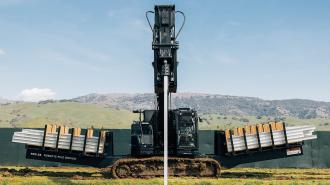California-based startup Built Robotics has unveiled a huge autonomous construction robot that speeds up the creation of utility-scale solar farms — accelerating the transition to a clean energy future and making workers safer, too.
The challenge: Electricity generation is responsible for more than 30% of the US’s carbon emissions, so transitioning the grid away from fossil fuels and toward renewables, such as solar, is essential to combating climate change. Not only that, we’ll need to generate a lot more electricity as we increasingly electrify cars, machines, and industry.
To meet the demands of the future, automation is gonna be key in the construction world.
Justin Russell
Constructing a utility-scale solar farm is a major undertaking, though: once a company goes through the potentially years-long process of finding a site and securing permits, it can still take another couple of years to build the solar farm.
Moreover, as solar panels have gotten dramatically cheaper, an increasingly large share of the cost of solar power is coming from things other than the panels themselves, like construction and labor. If we’re going to keep pushing the price of solar down, we’ll have to get more productive at those things, too.
The construction robot: Built Robotics has now unveiled RPD 35, an autonomous construction robot that accelerates an important part of building a utility-scale solar farm: installing solar piles.
These heavy steel beams are about 15 feet long, and during solar farm construction, they’re driven about eight feet into the ground — the part of the pile that remains exposed then serves as the foundation for a solar array.
They will take people out of harm’s way, reducing noise exposure, strain, struck-by and pinch hazards.
Noah Ready-Campbell
RPD 35 automates this process.
The massive construction robot can carry up to 200 piles at a time, lifting them out of an onboard basket and driving them into the ground at an average speed of one per 73 seconds. Onboard GPS tech ensures the piles are placed with an accuracy of less than one inch.
“Our software produces a pile sequence,” said Justin Russell, Built’s head of field operations. “The baskets on board the excavator are loaded in a particular sequence that allows for the placement of those piles in the exact right position in the exact right order.”
The impact: A 250 MW solar farm — one big enough to power about 100,000 homes — can require as many as 100,000 solar piles. Built says a two-person crew can install up to 300 piles per day with its construction robot, which is three to five times better than what is currently possible.
“Our piling robots will dramatically improve the efficiency of workers on job sites, which is critical in the chronically tight construction labor market,” said Built CEO Noah Ready-Campbell. “And just as importantly, they will take people out of harm’s way, reducing noise exposure, strain, struck-by and pinch hazards.”
Looking ahead: Automating pile driving is just one way Built is making it easier to establish utility-scale solar farms — the company has also built an automation system that can be added to the commercial excavators used to dig trenches for underground cables.
That system is already available, and Built plans to begin customer deployments of the RPD 35 before the end of 2023 — all while continuing to look for new ways to automate the dull, dirty, and dangerous work on solar construction sites.
“Here at Built, we’re in it for the long haul,” said Russell. “We believe that in order to meet the demands of the future, automation is gonna be key in the construction world. It’s the future.”
We’d love to hear from you! If you have a comment about this article or if you have a tip for a future Freethink story, please email us at [email protected].






